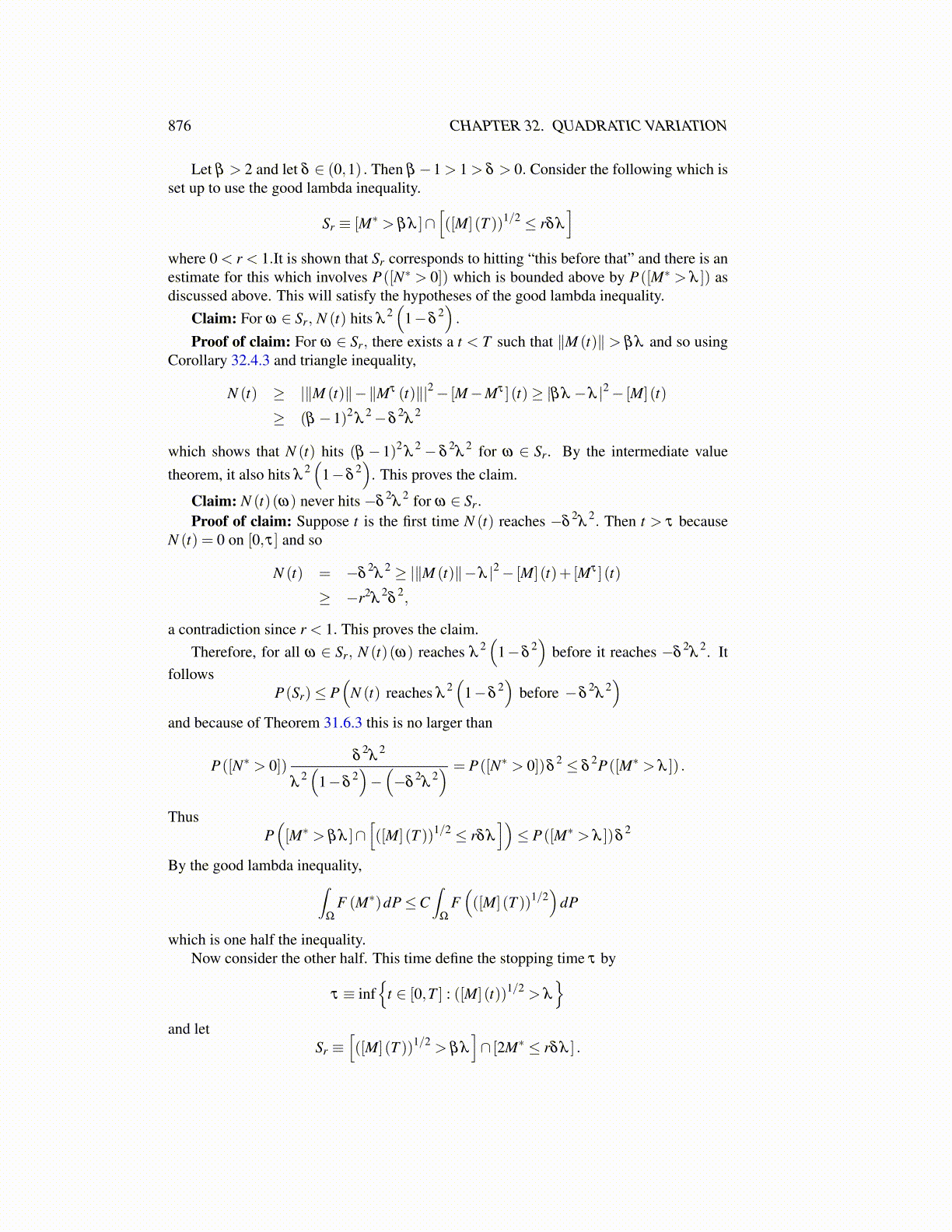
876 CHAPTER 32. QUADRATIC VARIATION
Let β > 2 and let δ ∈ (0,1) . Then β −1 > 1 > δ > 0. Consider the following which isset up to use the good lambda inequality.
Sr ≡ [M∗ > βλ ]∩[([M] (T ))1/2 ≤ rδλ
]where 0 < r < 1.It is shown that Sr corresponds to hitting “this before that” and there is anestimate for this which involves P([N∗ > 0]) which is bounded above by P([M∗ > λ ]) asdiscussed above. This will satisfy the hypotheses of the good lambda inequality.
Claim: For ω ∈ Sr, N (t) hits λ2(
1−δ2).
Proof of claim: For ω ∈ Sr, there exists a t < T such that ∥M (t)∥ > βλ and so usingCorollary 32.4.3 and triangle inequality,
N (t) ≥ |∥M (t)∥−∥Mτ (t)∥|2− [M−Mτ ] (t)≥ |βλ −λ |2− [M] (t)
≥ (β −1)2λ
2−δ2λ
2
which shows that N (t) hits (β −1)2λ
2 − δ2λ
2 for ω ∈ Sr. By the intermediate valuetheorem, it also hits λ
2(
1−δ2)
. This proves the claim.
Claim: N (t)(ω) never hits −δ2λ
2 for ω ∈ Sr.
Proof of claim: Suppose t is the first time N (t) reaches −δ2λ
2. Then t > τ becauseN (t) = 0 on [0,τ] and so
N (t) = −δ2λ
2 ≥ |∥M (t)∥−λ |2− [M] (t)+ [Mτ ] (t)
≥ −r2λ
2δ
2,
a contradiction since r < 1. This proves the claim.Therefore, for all ω ∈ Sr, N (t)(ω) reaches λ
2(
1−δ2)
before it reaches −δ2λ
2. Itfollows
P(Sr)≤ P(
N (t) reaches λ2(
1−δ2)
before −δ2λ
2)
and because of Theorem 31.6.3 this is no larger than
P([N∗ > 0])δ
2λ
2
λ2(
1−δ2)−(−δ
2λ
2) = P([N∗ > 0])δ
2 ≤ δ2P([M∗ > λ ]) .
ThusP([M∗ > βλ ]∩
[([M] (T ))1/2 ≤ rδλ
])≤ P([M∗ > λ ])δ
2
By the good lambda inequality,∫Ω
F (M∗)dP≤C∫
Ω
F(([M] (T ))1/2
)dP
which is one half the inequality.Now consider the other half. This time define the stopping time τ by
τ ≡ inf{
t ∈ [0,T ] : ([M] (t))1/2 > λ
}and let
Sr ≡[([M] (T ))1/2 > βλ
]∩ [2M∗ ≤ rδλ ] .